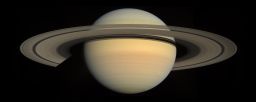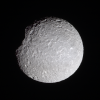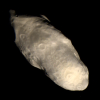Emily Lakdawalla • Dec 28, 2009
Planetary Society Advent Calendar for December 28: Ariel
Here's yet another of the moons of Uranus for you: Ariel, a near-twin in diameter to Umbriel, but apparently with more interesting geology. It has these cool flat-floored troughs. On Earth, I'd think flat-floored troughs were "graben," the flat valleys you get between steep mountains in places where the crust is expanding, like in the western U.S. or in the east African rift valley. Are the ones on Ariel graben? It'd be hard to say without better pictures, and who knows when we're going to get better pictures of Ariel.
Like all of the Uranian moons, only the southern hemispheres have been mapped in any detail, because it was nearly the southern summer solstice when Voyager 2 passed through the system in 1986. The southern hemispheres of Uranus and all its moons were bathed in continuous sunlight, the northern hemispheres continuously dark. So the northern hemispheres of all these moons are "terra incognita" -- or so it has been thought, until a couple of years ago. That's when image processing magician Ted Stryk took another look at the Voyager Uranus data and discovered that there were details visible on some of that northern hemisphere territory, extremely faintly lit by light reflected from Uranus.

Cassini does this sort of planetshine imaging at Saturn all the time, but it has a significantly more sensitive detector than Voyager 2 had, and Saturn (being both larger and closer to the Sun than Uranus) casts much more light onto the night sides of its moons than Uranus does (not to mention the fact that Saturn also has those great huge rings throwing light around the Saturn system). Still, in hindsight, it's kind of surprising that nobody thought to look for this detail in the night sides of the Uranian moons before. Ted was the one who did it, and it was Ariel that benefited the most; Ted has wrung almost a complete global view of the moon out of the Voyager data. He wrote about this work in a guest blog post here last year: "pulling out new detail in old data provides our only opportunity to get a peek at what lurks in the in the unmapped regions of its fascinating moons." That's why he, and I, and lots of other people, get so much enjoyment out of digging into these old image catalogs.
Each day in December I'm posting a new global shot of a solar system body, processed by an amateur. Go to the blog homepage to open the most recent door in the planetary advent calendar!
Support our core enterprises
Your support powers our mission to explore worlds, find life, and defend Earth. You make all the difference when you make a gift. Give today!
Donate

 Explore Worlds
Explore Worlds Find Life
Find Life Defend Earth
Defend Earth





























